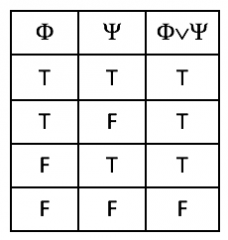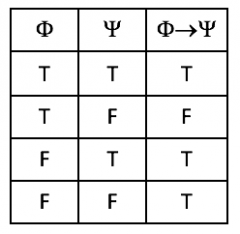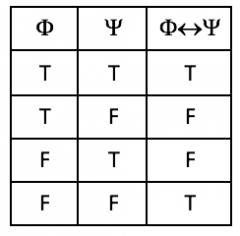![]()
![]()
![]()
Use LEFT and RIGHT arrow keys to navigate between flashcards;
Use UP and DOWN arrow keys to flip the card;
H to show hint;
A reads text to speech;
33 Cards in this Set
- Front
- Back
|
What is an ordered pair? |
An ordered pair comprises two components in a given order |
|
|
What is a binary relation? |
A set is a binary relation iff it only contains only orderedpairs |
|
|
Define Reflexive |
Iff every element in the set is related toitself, ∀x(Sx → Pxx) |
|
|
Define Symmetric |
Iff when its true that Rab its true that Rba ∀x∀y((Sx ⋀ Sy) → (Pxy ⋀ Pyx)) |
|
|
Define Asymmetric |
Iff for no elements d,e, if {d,e} then {e,d} ∀x ¬∃y(Sx ⋀ Sy ⋀ Pxy ⋀ Pyx) |
|
|
Define Antisymmetric |
Iff no 2 different elements have symmetry |
|
|
Define Transitive |
Iff a is related to b, is related to c, isrelated to a ∀x∀y∀z(Sx ⋀ Sy ⋀ Sz ⋀ Pxy ⋀ Pyz → Pxz) |
|
|
Define Equivalence Relationship |
Iff R is reflexive, symmetric and transitive onS |
|
|
Define a Function |
A function is a sentence that assumes a value of true or false |
|
|
What characteristics does the empty set have? |
The relation ∅isreflexive on the empty set but on no other set, it is symmetric but alsoantisymmetric and asymmetric, it is also transitive |
|
|
What is an argument? |
An argument consists of a set of declarative sentences(premises) and a declarative sentence (conclusion) |
|
|
What is a valid argument? |
A valid argument must have no hidden assumptions |
|
|
What is a logically valid argument? |
An argument is logically valid iff there is nointerpretation where the premises are all true and the conclusion is false |
|
|
Define logically consistent |
A set of sentences is logically consistent iff thereis at least one interpretation under which all sentences of the set are true |
|
|
Define logically true |
A sentence is logically true iff it is true under anyinterpretation |
|
|
Define a contradiction |
A sentence is a contradiction iff it is false underall interpretations |
|
|
Define logically equivalent |
Sentences are logically equivalent iff they are trueunder exactly the same interpretations |
|
|
Bracketing Conventions |
⋀ and ⋁ bind more strongly than → and ↔, You can drop the outer brackets You can drop the brackets on strings of ⋀ and ⋁ |
|
|
What is the object language and the metalanguage? |
L1 is the object language, English is themetalanguage |
|
|
⋀ Truth Table
|

|
|
|
⋁ Truth Table |

|
|
|
→ Truth Table |

|
|
|
↔ Truth Table |

|
|
|
What are truth functional connectives? |
Truth functional iff truth value of a compound sentencecannot be changed when replacing a direct sub-sentence with one of the sametruth-value |
|
|
Rules of Thumb for → |
‘If’ mid-sentence corresponds to ← ‘Only if’ corresponds to → |
|
|
What is an arity-index? |
Each predicate letter has an arity-index that corresponds tothe number of designators the predicate expression can take |
|
|
What is a counterexample? |
A L2 structure Ais a counterexample to an argument iff all premises of the argument are true inA and the conclusion isfalse in A Create a complete dictionary where the Premises are true andthe Conclusion is false, often use numbers |
|
|
Complete and Reflexive Example |
S = {1}, R = {<1,1>} |
|
|
Complete and Symmetric Example |
S = {1}, R = {<1,1>} |
|
|
Transitive, Asymmetric and Not Complete |
S = {1,2,3}, R = {<1,2>, <2,2>, <1,3>} |
|
|
Complete and Not Symmetric |
S = {1,2}, R = {<1,1>, <1,2>, <2,2>} |
|
|
Can a complete and non-empty set be reflexive? |
A complete and non-empty set must be reflexive as if a e R then <a,a> e R so it cannot be the case that there is some a e R such that <a,a> is not e R,a>,a> |
|
|
Propositionally Valid |
An argument is propositionally valid iff it's L1 formalisation is valid |

